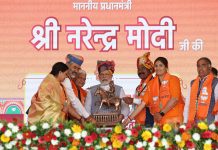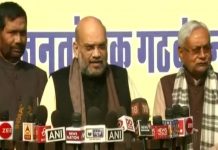 Humour — in all its formats including a cartoon, a video clip or an Internet meme – has become an integral part of the social media. People quite frequently and freely share jokes on Facebook, WhatsApp and other mobile and online applications, often not knowing who created those humorous items or initiated their transmission in cyberspace. Majority of the people look at them as a small break from their monotonous daily routine, but some see it as serious business. These jokes, no doubt, influence us in ways beyond having a good laugh.
Humour — in all its formats including a cartoon, a video clip or an Internet meme – has become an integral part of the social media. People quite frequently and freely share jokes on Facebook, WhatsApp and other mobile and online applications, often not knowing who created those humorous items or initiated their transmission in cyberspace. Majority of the people look at them as a small break from their monotonous daily routine, but some see it as serious business. These jokes, no doubt, influence us in ways beyond having a good laugh.
A handful of people raise awareness about social problems and their solutions through these creative pastimes. But not everyone uses them for societal benefits. While corporate players use humour to promote their products and services and beat their rivals, political parties and social scientists utilise it to strengthen their position among the masses and spread negativity against their opponents. Some times, these social media posts are used to spread lies about particular individuals or communities. At other times, they are derogatory and blasphemous in attempt to stereotype few people or a section of the society; more so, during election campaigns.
Most of the times, jokes among colleagues or friends taking aim at bosses or politicians are harmless. They may even be downright hilarious with a positive bonding effect for those who get the humour. But there are situations when such humour produces negative effects, and these are not necessarily about the impact on individual physical and mental health. Jokes that result from prejudice or purportedly humorous statements that are highly insensitive and offensive to race and religion can result in dismissal, disharmony, distrust and even death. Practical jokes in the form of fake news on the Internet may be funny to those propagating them but can end up wasting public resources or causing serious damage in crisis situations.
This is not to say that the trend of making fun of others is new in India. Stereotypes of ethnic, religious or caste groups had been rampant even before the advent of Internet and social media. People had always been making sweeping generalisations — and jokes — about compatriots from other communities and groups. Bengalis, for example, are considered loquacious book lovers, all talk and no action. Gujaratis are believed to be shrewd business-minded people. Parsis are treated as eccentric, with an unusually high proportion of unmarried men. South Indians are mocked for their strong accents and their dependence on coconut oil. The latest victims of the humour-mongers are Muslim men, who are being accused of divorcing their wives at the drop of a hat and so-called love jihad, etc.
But the Sikh community, which constitutes only around two per cent of the country’s total population, has been the worst target of these jokes, particularly after the 1984 riots. Since late nineties, when the Internet became popular in India, hundreds of websites dedicated exclusively to ‘<Sardar> jokes’ have come up. The community, however, did not find it funny and filed a public interest litigation (PIL), seeking a ban on Sardar jokes’ promulgation both online and offline.
In 2015, a two-judge bench of the Hon’ble apex court — headed by Ex-Chief Justice TS Thakur — had agreed to hear the PIL. In the list of contentions drawn out by Shiromani Gurudwara Prabandhak Committee (SGPC), issues like “racial profiling” and “bullying/ragging” were highlighted. It was welcomed by the then chief justice. However, the March 2017 hearing in the PIL by a bench headed by Justice Dipak Misra dashed all hopes of a complete ban on Sardar jokes. The apex court observed that it had no right to frame guidelines on the issue and asked the aggrieved to opt for alternate mechanism like section 67A of the Information Technology Act, 2000 or to seek justice under the relevant sections of the Indian Penal Code (IPC). “If anything is surfacing on social media, anyone can take a recourse under 67A of the IT Act or under the IPC. How can we, under Article 32, lay guidelines and what kind of guidelines should be laid? We are not getting into concept of joke and all. Question is what kind of guidelines this
court can lay down?” asked Justice Dipak Misra, the current Chief Justice of India..
In another petition filed last year, a student of Amity Law School complained of how the Gorkha community is typecast with “a topi and khukhri” on the Internet. “This court cannot lay down moral guidelines for citizens. People must have mutual restraint. The law is the same for all in this country,” an apex court bench of Justices Dipak Misra and R. Banumathi had said last year.
This, in a way, closed the door for a blanket ban on any kind of humour, even if it has a very negative impact on the image of a particular community. The litigant may go to court on case by case basis. Thus, lack of guidelines to regulate ill-intentioned humorous content on the social media has made individuals and communities more vulnerable to online punny attacks. Constant stereotyping, as per senior advocate Harvinder Choudhary, holds the growth of a particular community and affects it in the long run. The only easy way out seems to counter-respond the aggressor in the same tone.
But that’s not the solution. After all, the Scheduled Castes and the Scheduled Tribes have a vigorous law to protect them from insults. It can be done to safeguard the image of other communities too. The court, as Justice Misra had then put it, cannot frame moral guidelines on how people should react to jokes. However, the Parliament has complete authority to make legislations required to curb misuse of freedom of speech and punish those who disrespect fellow citizens online and offline.
At the individual level, social media users also need to act more responsibly and should not fall for the hate, propaganda and lies spread on cyberspace. An army of sincere Netizens may help curb rumours and make the general public aware about why and how they should crosscheck every post and joke shared with them in the cyberspace. Smiling at the cost of someone else’s dignity may hurt the social fabric of society. Responding and counter-responding to a negative post will turn the whole activity into a vicious cycle of hatred. A witty, but graceful and harmless, response should be enough for any cartoon, video clip or Internet meme aimed at you or your community.
letters@tehelka.com











